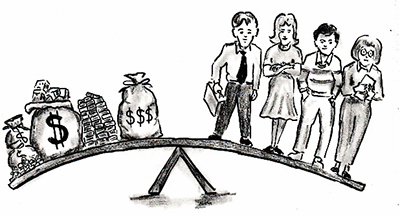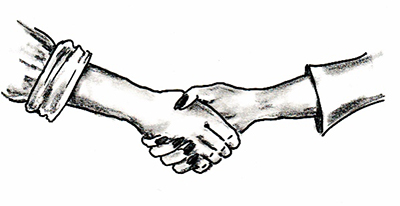Sort Articles:
Preparation for Building a Culture
Written by: Ralph Twombly
Published: Tue Mar 29 2022 10:58:34 GMT-0400 (Eastern Daylight Time)
“… are we to be controlled by accidents, by tyrants, or by ourselves in effective cultural design?”
Burrhus Frederic Skinner
Before we pull the curtain to reveal the magic of building a culture, it will help to disclose a few discoveries I made while working with three developing organizations. By discussing their stories, I believe it will expose some of the dangers and landmines I spoke of earlier.
As a facilitator of our workshops, I learned to adapt to the personality of each group that came to us for assistance. This provided me an insight into the inner working of each organization. It helped me understand why their stories make a valuable learning tool.
Keep in mind any new idea, such as introducing cultural work, has its detractors, doubters and nay-sayers.
 It’s useful to recall the wisdom of television newscaster David Brinkley, who said, “A successful man is one who can lay a firm foundation with the bricks others have thrown at him.” These stories demonstrate the journey we took and the risks involved.
It’s useful to recall the wisdom of television newscaster David Brinkley, who said, “A successful man is one who can lay a firm foundation with the bricks others have thrown at him.” These stories demonstrate the journey we took and the risks involved.
The first story describes a manufacturer who hoped to develop strong leaders throughout his company. The process started on an encouraging path. The people who attended our workshops seemed sincere and eager to learn. But as the workshops continued, something strange happened. I noticed they had a hard time focusing on our message. They wandered off during breaks – both in a physical and emotional sense, made constant phone calls and got caught up in other distractions.
I was puzzled by their short attention to the topics we covered. Their distractions told me to look further. I found the answer when I discovered details about the company. I learned it had a pattern of expanding and contracting as business cycles evolved. When demand for their product was high, they hired more staff. When business dropped, they laid off people – sometimes 30 percent or more at a time. This constant ebb and flow made the employees have an insecure feeling about the company and concern for their jobs.
I realized the company used its people, the largest expense in any manufacturing organization, as a way to balance its budget. Without any warning, an employee could be among those let go with the next drop in business.

When the company sent people to our workshops, their loyalty to the company was on shaky ground. Their participation in our workshops became lackluster and uninspired. Worry and fear sidetracked them. The lack of job security distracted them and caused them to live moment-to-moment. As they struggled with this confusion it became impossible for them to learn and grow. I felt it only fair to describe this unsettling feeling with the business owners. We both realized the idea of building a healthy culture would be impossible.
 It recalls the old saying, “It’s hard to drain the swamp when you’re up to your butt in alligators.” In order to clear the way to build a culture, they had to get rid of the “alligators” that caused their employees to feel threatened by losing their jobs. Once the company knew the source of the problem of low employee morale, they worked to maintain their workforce through their difficult cyclical economy.
It recalls the old saying, “It’s hard to drain the swamp when you’re up to your butt in alligators.” In order to clear the way to build a culture, they had to get rid of the “alligators” that caused their employees to feel threatened by losing their jobs. Once the company knew the source of the problem of low employee morale, they worked to maintain their workforce through their difficult cyclical economy.
The second story had an even more ominous outcome. Once again, an organization contacted me about building their culture. They recognized they had serious problems. Their heavy-handed management style frustrated innovation. While they grew, even in a shrinking market, communication between departments suffered and confidence deteriorated.
Determined to correct the downward slide, the company devoted time, money and support to establish an effective culture. In the first two years we made significant progress. We created a nimble organization that brought the best ideas to the surface, retained leaders and developed employees. Staff at all levels received business cards to create a feeling of ownership. People felt like they could speak up to leaders with innovative plans to give support to the community.
I heard the heartwarming story of Harry, a technician, who visited a home that needed work done. To his surprise, Harry discovered the owner of the home was so desperate for help he lied that he was a customer. Rather than abandoning the homeowner, Harry took the initiative and fixed the problem. When he went back to the office Harry told his boss to take any charges for the visit out of his next paycheck. Harry’s boss smiled and wrote the experience off as a good gesture for the community.
 This is just one example of the positive work environment the company cultivated. People lined up to work for them, they were making inroads to their market and they were building trust at each level every day.
This is just one example of the positive work environment the company cultivated. People lined up to work for them, they were making inroads to their market and they were building trust at each level every day.
All this good work changed with a phone call from one of the owners. He told me the company had been sold to a bigger organization. “Don’t worry,” he said. “I told them our company had an agreement with you for additional cultural training for the rest of the year. All employees and benefits will continue.”
I learned the bigger organization bought the smaller company because of the strong culture we helped them build. But we both found out we were building on sand.
In the end the bigger organization used its own methods and practices to absorb the smaller company. We all felt betrayed. No doubt many of the employees believed we were part of the betrayal.
 At the time of this writing, the organization has been sold again. Perhaps they are looking to reestablish the culture we helped build in the original company. Hope springs eternal.
At the time of this writing, the organization has been sold again. Perhaps they are looking to reestablish the culture we helped build in the original company. Hope springs eternal.
The third story has all the drama of a mystery thriller with an on-going legacy. It is filled with amazing success, painful setbacks, unfortunate tragedy and forward-looking survivors.
It started just after the great recession of 2008. Like so many businesses, we almost lost everything. The news was filled with disastrous economic reports with no end in sight. Subprime mortgage rates aggravated the crisis as banks encouraged home lending to purchasers with questionable credit. When the housing bubble burst, “too big to fail” lending institutions held worthless investments. Unemployment dropped to 10% in 2009.
It was a painful time, but somehow we muddled through it. As the recession ended, we got a call from a desperate business Chief Executive Officer. He had visited one of the clients we worked with to develop a thriving culture and felt intrigued about the process. He knew his business faced serious leadership, organizational and staff loyalty problems and wondered if we could help.
We started the journey with the senior team and determined the culture that existed throughout the organization. We formed a steering committee and asked employees to evaluate the company. Their candid answers showed a long list of grievances, most pointing at top management. They included words like abusive, bully, angry, cruel and nasty. Sensing we were making headway, the CEO asked us to evaluate their senior managers. I reported that one of them was not a team player and had to leave the company.
Next, we worked on a charter, which would evolve through the years. We established crews and continued to get feedback about progress and encourage new ideas. The momentum for improvement built and the group learned how to make sales grow. People began to manage their own expectations.
We trained managers to raise the bar for excellence and good performance.
 The process came as a result of steady improvements and teamwork over a period of ten years – all without adding a dollar of incentive. In the ten years after they started their cultural journey, they have doubled their growth, added a third more people, and became first in their class as the best place to work in the statewide survey. They had arrived.
The process came as a result of steady improvements and teamwork over a period of ten years – all without adding a dollar of incentive. In the ten years after they started their cultural journey, they have doubled their growth, added a third more people, and became first in their class as the best place to work in the statewide survey. They had arrived.
In spite of the success, there were a few casualties along the way. Some employees did not have the capacity or desire to grow with the organization. As you might expect, they were among those listed as a problem in early feedback. They moved on to other fields.
Without question, the greatest catastrophe was the heartbreaking loss of the CEO, who championed the entire process. He lost the struggle to cancer which cost the organization its spiritual leader. Although the legacy of his leadership lives on to this day.
To demonstrate the strength and confidence the organization had with the culture they built, they rejected an opportunity to merge with another good company. They knew their cultural standards would clash.
It is not an exaggeration to say this is a progressive and high-performing organization. Employees feel free to become leaders at all levels, they develop talent, they encourage people to balance their lives, they support one another, and they treat us and all their vendors as family.
 They are finding ways to hire people who fit in the organization. They are learning that they need to be more accepting and better at helping people who want to join their organization. They work hard together selflessly - and that is rare. This will not change if they keep up this cultural pace.
They are finding ways to hire people who fit in the organization. They are learning that they need to be more accepting and better at helping people who want to join their organization. They work hard together selflessly - and that is rare. This will not change if they keep up this cultural pace.
They are learning the meaning of accountability and hungrily gobble up every bit of excellence and knowledge they can get.
I found that initial feedback when we started. It filled 16 pages of 12-point font in a word document and was about 80% negative. As I mentioned earlier, to quote one of the courageous souls who was there at the start, “We went from a drama-infested hellhole to the Best Place to Work in ten years.”
I am anticipating that the initiatives they are taking on, such as better levels of service to customers, better employee experience, growing sales and superior technology will place them front and center in their competitive world for years to come. It will also be a place where people will learn and thrive, gain confidence and be happy and excited to come to work each day. They know what they want, and they are a particular about getting it. Shouldn’t we all be?
What People Want and Need
The reason I relate the first two stories that ended in disappointment is to emphasize how unpredictable and challenging cultural work can be. Even when we make progress it can collapse for any number of reasons that are out of our control.
I also love to tell the third story. It demonstrates how cultural work can achieve exciting and productive results. But take care. The job is never done and must be nurtured and reinforced at all levels.
While there can be a great deal of uncertainty in our work, I believe it is safe to say there are a number of realities you can count on. I described them in my previous book, “The Leadership Makers.” I shared my view that people’s motivations are predictable. You can describe them in three ways:
- People want permanence.
They want to know their job will be there as long as they give more than they receive.
- People want to be appreciated
They want to believe their work has significance and they might leave a legacy.
- People want to learn and grow
They thirst for knowledge about their job, their company and profession.
 If company leaders can view their employees as individual who want to be included and appreciated for their hard work, bright minds and good souls, they’re on the road to building a successful culture.
If company leaders can view their employees as individual who want to be included and appreciated for their hard work, bright minds and good souls, they’re on the road to building a successful culture.
Culture is Built on Six Pillars
This is an excellent place to start the conversation on the specifics for building a culture. Even though we acknowledge how complex it can be, we found cultural work has a methodology. Like fixing your car are remodeling your home, you need to find the problem you want to solve, make a plan, get the tools and find knowledgeable people to show you how to proceed.
Our experience has taught us a culture is built on 6 pillars. Each will be described in detail in later chapters.

- Pillar One: Leadership
Leaders who champion the idea of a culture and set the agenda with commitment and passion.
- Pillar Two: Measure
Initiate and be responsible for a periodic measurement of existing and preferred culture.
- Pillar Three: Steering
Commit to a continual, rotating steering team made of diverse representatives of people in the organization.
- Pillar Four: Charter
Have your people build a charter annually that creates proactive behavior for the year ahead.
- Pillar Five: Feedback
Give and receive feedback and input from all the people in the organization monthly.
- Pillar Six: Task Team
Create highly accountable and nimble task teams to lead the change.
Before we head into the First Pillar… a Few Cautionary Notes.
To state the obvious, people are different. They have their beliefs, values, standards and agendas. Their actions become an extension of these qualities.
One of the main reasons why leaders fail is they push when they should pull. To push means that you know the way and others must follow. This is the “Get on board, do it my way, because my way is the only way” approach. The by-product of push is that people feel demeaned. If people are pushed hard enough, they dumb-down to avoid the conflict with the boss and you will never get their best.
An alternative is to move to a place that honors people’s minds as well as the skill that they bring. This is pull. We follow people who believe what we believe. It inspires us to do more than asked. We understand the leader, whom we learn to believe in and trust. We feel validated by following their lead. People go because they want to, and they only want to go when their best interests and values are satisfied. It takes a little training for leaders to get the hang of cultural work. Learning about pull is an important piece of the work ahead.
Beware and be aware. Organizations that focus on one initiative, then go on to the next idea, book, fad, or guru slogan need to avoid cultural work. They follow a fool’s errand.
Serious cultural work is designed to build strong teams, a nimble business, allow innovation and create sustainability. Be prepared for change working every day. People in culturally rich organizations don’t respond to change. They initiate change before it is forced upon them. They ask for nothing more than the feeling that every successful entrepreneur knows, ownership.
Ready? Let’s open the curtain and get to the magic!
Ralph Twombly
In the 20 years since starting Priority Learning, Ralph has facilitated countless learning experiences and has conducted training for thousands of managers and leaders. With over 30 years of leadership development and organizational development background and work, Ralph continues to build relationships with client companies all over the U.S.

